Negotiation Analysis Report: Thinking Styles, Strategies, and ZOPA
VerifiedAdded on 2021/05/31
|10
|2443
|69
Report
AI Summary
This report analyzes negotiation strategies, focusing on the author's preferred thinking style (anarchic) and scope (external) and their suitability for a sales negotiation scenario. The report discusses the adjustments needed to optimize the thinking style for the negotiation. It identifies the client's and the other party's BATNA (Best Alternative To a Negotiated Agreement) and reservation values, and calculates the ZOPA (Zone of Possible Agreement). The report outlines the negotiation process with the buyer, detailing initial offers, counteroffers, and the eventual agreed-upon price. The author emphasizes the importance of understanding the value of the property and the alternatives available to both parties. The report provides a detailed account of the negotiation, incorporating insights from the buyer's perspective and relevant negotiation strategies.
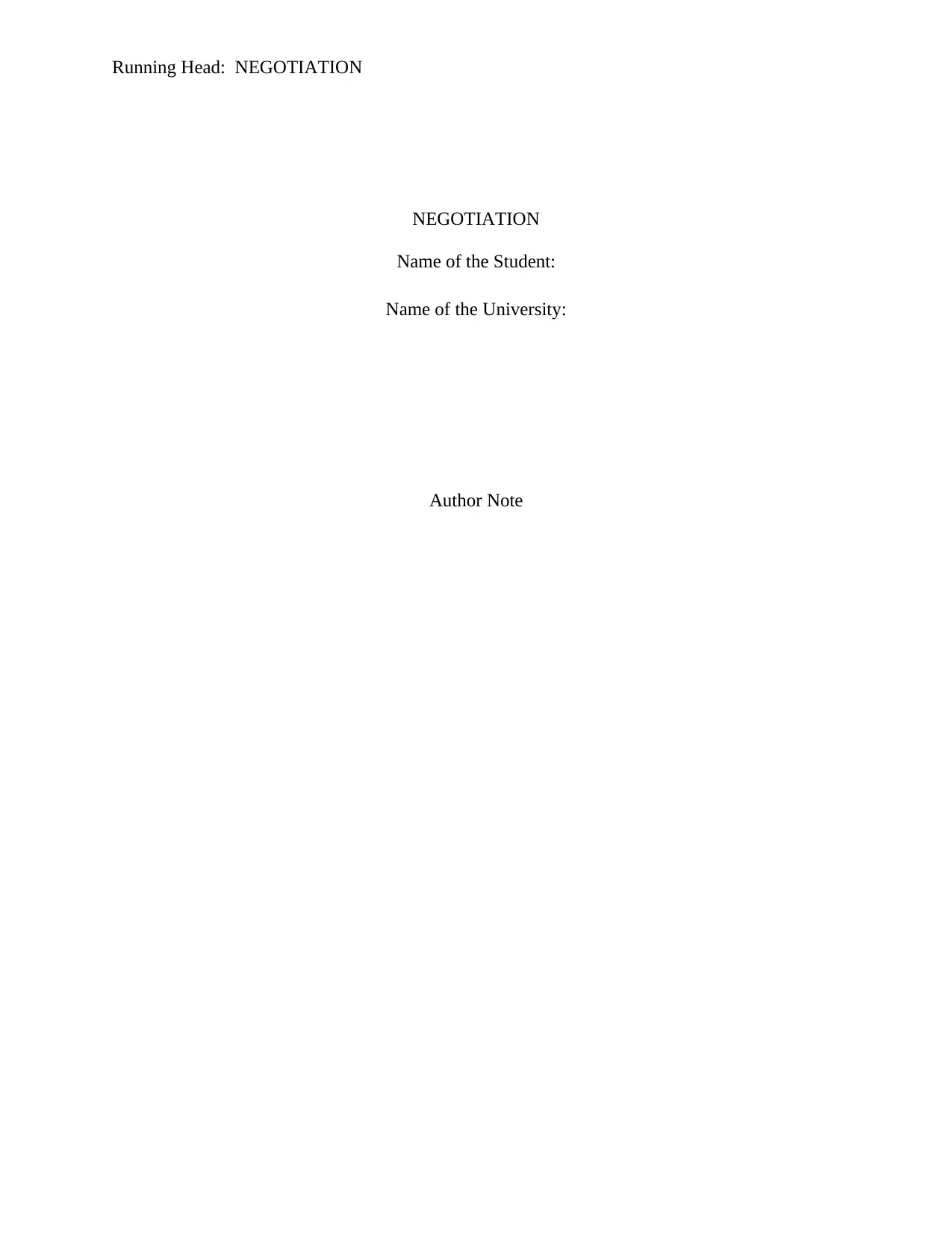
Running Head: NEGOTIATION
NEGOTIATION
Name of the Student:
Name of the University:
Author Note
NEGOTIATION
Name of the Student:
Name of the University:
Author Note
Paraphrase This Document
Need a fresh take? Get an instant paraphrase of this document with our AI Paraphraser
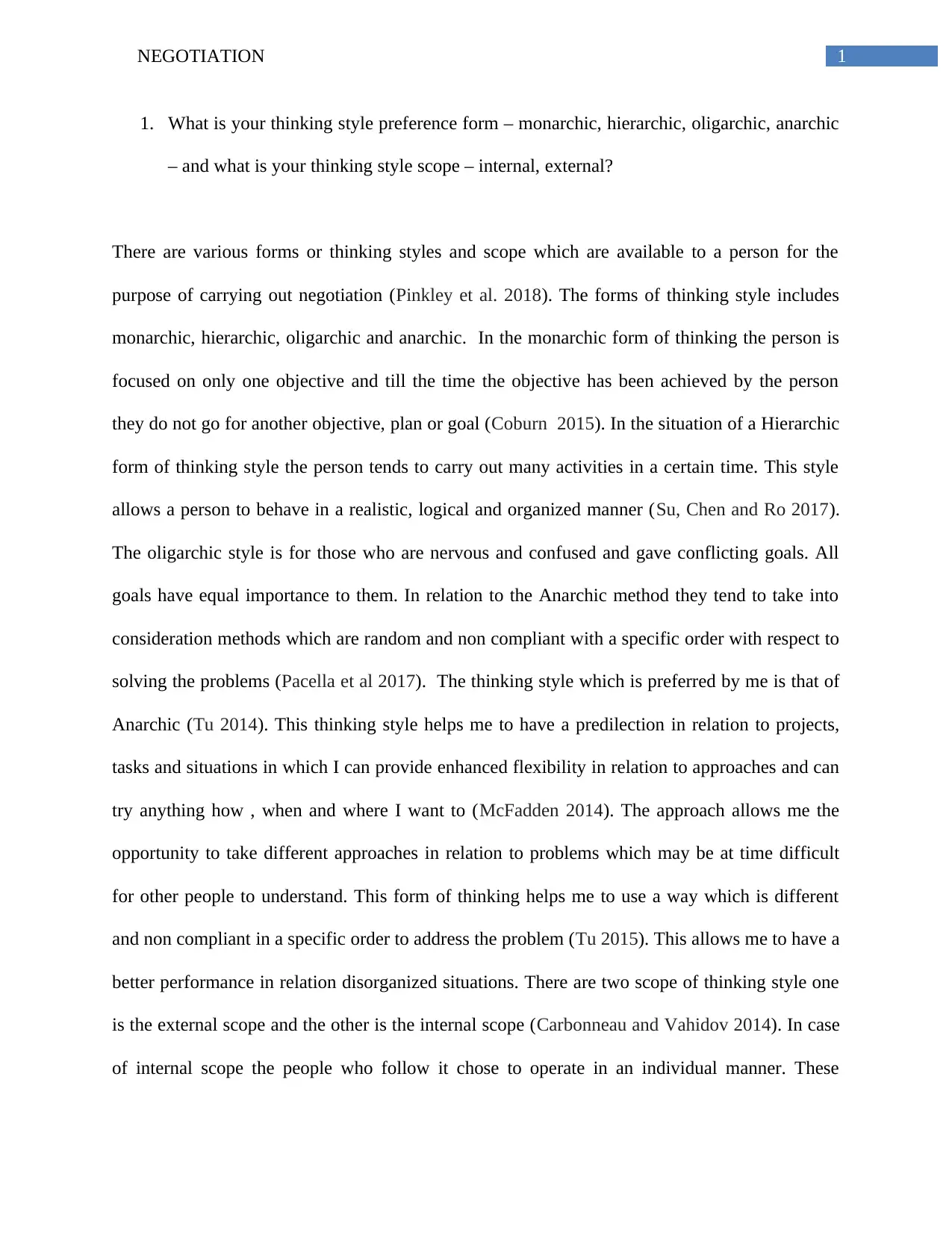
1NEGOTIATION
1. What is your thinking style preference form – monarchic, hierarchic, oligarchic, anarchic
– and what is your thinking style scope – internal, external?
There are various forms or thinking styles and scope which are available to a person for the
purpose of carrying out negotiation (Pinkley et al. 2018). The forms of thinking style includes
monarchic, hierarchic, oligarchic and anarchic. In the monarchic form of thinking the person is
focused on only one objective and till the time the objective has been achieved by the person
they do not go for another objective, plan or goal (Coburn 2015). In the situation of a Hierarchic
form of thinking style the person tends to carry out many activities in a certain time. This style
allows a person to behave in a realistic, logical and organized manner (Su, Chen and Ro 2017).
The oligarchic style is for those who are nervous and confused and gave conflicting goals. All
goals have equal importance to them. In relation to the Anarchic method they tend to take into
consideration methods which are random and non compliant with a specific order with respect to
solving the problems (Pacella et al 2017). The thinking style which is preferred by me is that of
Anarchic (Tu 2014). This thinking style helps me to have a predilection in relation to projects,
tasks and situations in which I can provide enhanced flexibility in relation to approaches and can
try anything how , when and where I want to (McFadden 2014). The approach allows me the
opportunity to take different approaches in relation to problems which may be at time difficult
for other people to understand. This form of thinking helps me to use a way which is different
and non compliant in a specific order to address the problem (Tu 2015). This allows me to have a
better performance in relation disorganized situations. There are two scope of thinking style one
is the external scope and the other is the internal scope (Carbonneau and Vahidov 2014). In case
of internal scope the people who follow it chose to operate in an individual manner. These
1. What is your thinking style preference form – monarchic, hierarchic, oligarchic, anarchic
– and what is your thinking style scope – internal, external?
There are various forms or thinking styles and scope which are available to a person for the
purpose of carrying out negotiation (Pinkley et al. 2018). The forms of thinking style includes
monarchic, hierarchic, oligarchic and anarchic. In the monarchic form of thinking the person is
focused on only one objective and till the time the objective has been achieved by the person
they do not go for another objective, plan or goal (Coburn 2015). In the situation of a Hierarchic
form of thinking style the person tends to carry out many activities in a certain time. This style
allows a person to behave in a realistic, logical and organized manner (Su, Chen and Ro 2017).
The oligarchic style is for those who are nervous and confused and gave conflicting goals. All
goals have equal importance to them. In relation to the Anarchic method they tend to take into
consideration methods which are random and non compliant with a specific order with respect to
solving the problems (Pacella et al 2017). The thinking style which is preferred by me is that of
Anarchic (Tu 2014). This thinking style helps me to have a predilection in relation to projects,
tasks and situations in which I can provide enhanced flexibility in relation to approaches and can
try anything how , when and where I want to (McFadden 2014). The approach allows me the
opportunity to take different approaches in relation to problems which may be at time difficult
for other people to understand. This form of thinking helps me to use a way which is different
and non compliant in a specific order to address the problem (Tu 2015). This allows me to have a
better performance in relation disorganized situations. There are two scope of thinking style one
is the external scope and the other is the internal scope (Carbonneau and Vahidov 2014). In case
of internal scope the people who follow it chose to operate in an individual manner. These
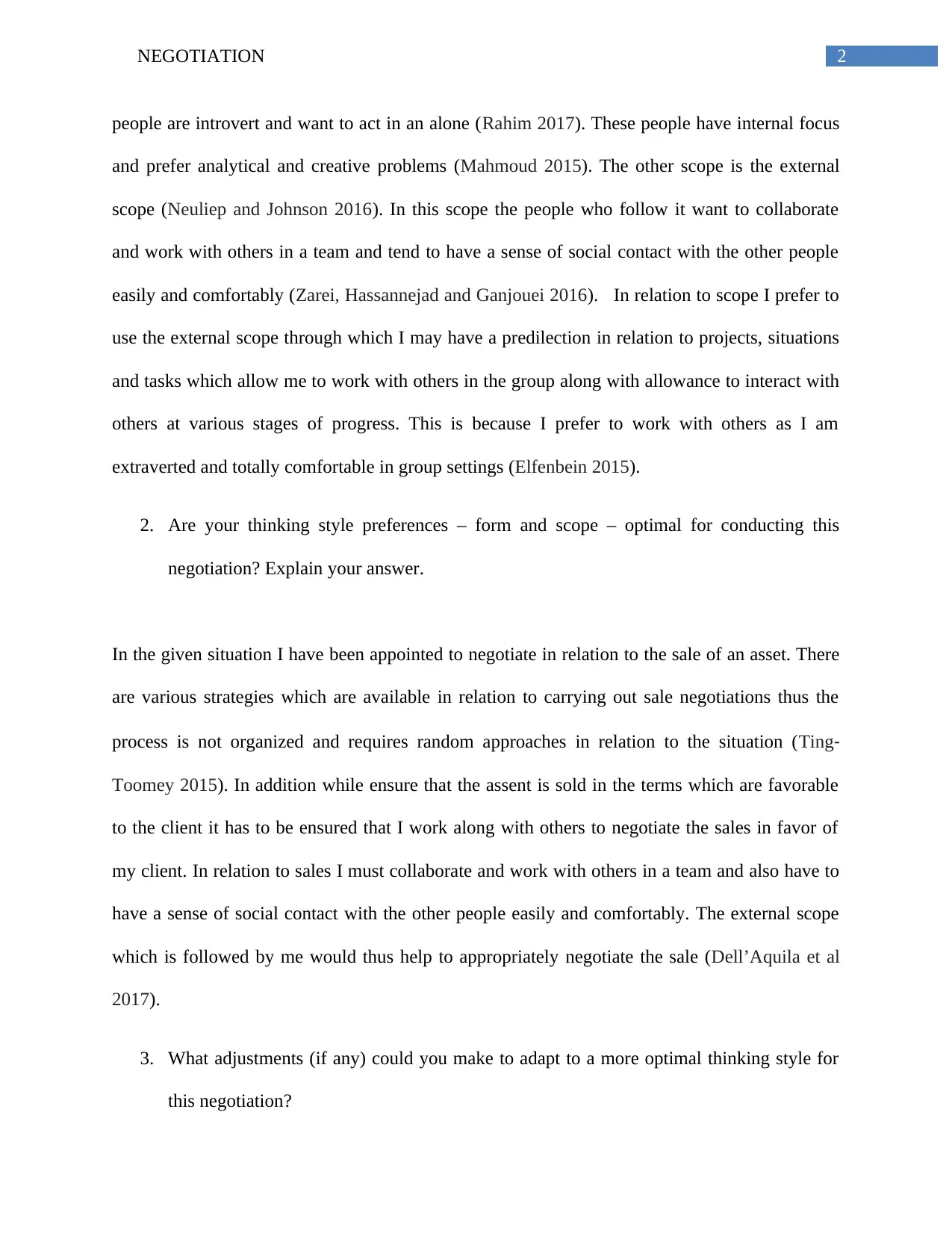
2NEGOTIATION
people are introvert and want to act in an alone (Rahim 2017). These people have internal focus
and prefer analytical and creative problems (Mahmoud 2015). The other scope is the external
scope (Neuliep and Johnson 2016). In this scope the people who follow it want to collaborate
and work with others in a team and tend to have a sense of social contact with the other people
easily and comfortably (Zarei, Hassannejad and Ganjouei 2016). In relation to scope I prefer to
use the external scope through which I may have a predilection in relation to projects, situations
and tasks which allow me to work with others in the group along with allowance to interact with
others at various stages of progress. This is because I prefer to work with others as I am
extraverted and totally comfortable in group settings (Elfenbein 2015).
2. Are your thinking style preferences – form and scope – optimal for conducting this
negotiation? Explain your answer.
In the given situation I have been appointed to negotiate in relation to the sale of an asset. There
are various strategies which are available in relation to carrying out sale negotiations thus the
process is not organized and requires random approaches in relation to the situation (Ting‐
Toomey 2015). In addition while ensure that the assent is sold in the terms which are favorable
to the client it has to be ensured that I work along with others to negotiate the sales in favor of
my client. In relation to sales I must collaborate and work with others in a team and also have to
have a sense of social contact with the other people easily and comfortably. The external scope
which is followed by me would thus help to appropriately negotiate the sale (Dell’Aquila et al
2017).
3. What adjustments (if any) could you make to adapt to a more optimal thinking style for
this negotiation?
people are introvert and want to act in an alone (Rahim 2017). These people have internal focus
and prefer analytical and creative problems (Mahmoud 2015). The other scope is the external
scope (Neuliep and Johnson 2016). In this scope the people who follow it want to collaborate
and work with others in a team and tend to have a sense of social contact with the other people
easily and comfortably (Zarei, Hassannejad and Ganjouei 2016). In relation to scope I prefer to
use the external scope through which I may have a predilection in relation to projects, situations
and tasks which allow me to work with others in the group along with allowance to interact with
others at various stages of progress. This is because I prefer to work with others as I am
extraverted and totally comfortable in group settings (Elfenbein 2015).
2. Are your thinking style preferences – form and scope – optimal for conducting this
negotiation? Explain your answer.
In the given situation I have been appointed to negotiate in relation to the sale of an asset. There
are various strategies which are available in relation to carrying out sale negotiations thus the
process is not organized and requires random approaches in relation to the situation (Ting‐
Toomey 2015). In addition while ensure that the assent is sold in the terms which are favorable
to the client it has to be ensured that I work along with others to negotiate the sales in favor of
my client. In relation to sales I must collaborate and work with others in a team and also have to
have a sense of social contact with the other people easily and comfortably. The external scope
which is followed by me would thus help to appropriately negotiate the sale (Dell’Aquila et al
2017).
3. What adjustments (if any) could you make to adapt to a more optimal thinking style for
this negotiation?
⊘ This is a preview!⊘
Do you want full access?
Subscribe today to unlock all pages.

Trusted by 1+ million students worldwide
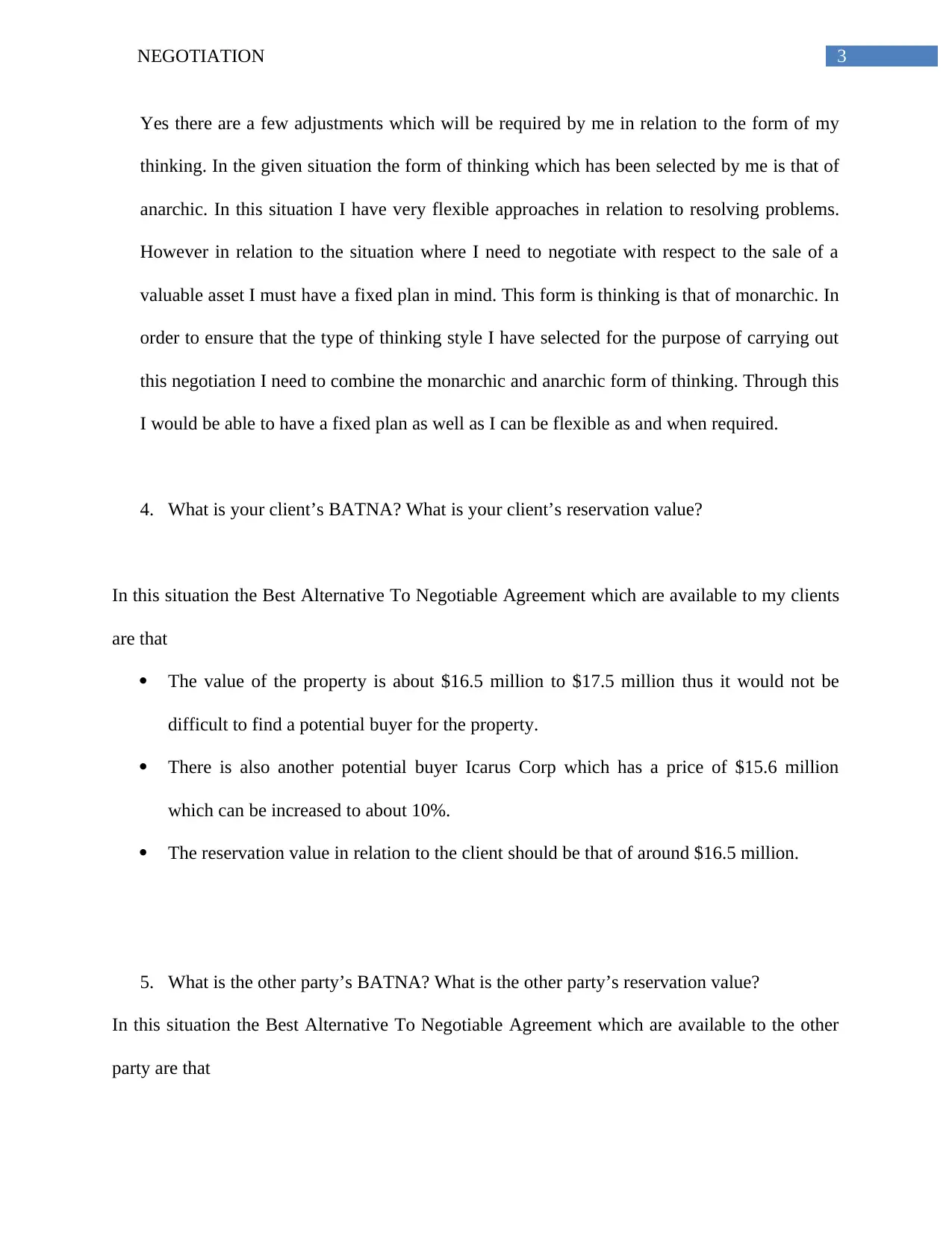
3NEGOTIATION
Yes there are a few adjustments which will be required by me in relation to the form of my
thinking. In the given situation the form of thinking which has been selected by me is that of
anarchic. In this situation I have very flexible approaches in relation to resolving problems.
However in relation to the situation where I need to negotiate with respect to the sale of a
valuable asset I must have a fixed plan in mind. This form is thinking is that of monarchic. In
order to ensure that the type of thinking style I have selected for the purpose of carrying out
this negotiation I need to combine the monarchic and anarchic form of thinking. Through this
I would be able to have a fixed plan as well as I can be flexible as and when required.
4. What is your client’s BATNA? What is your client’s reservation value?
In this situation the Best Alternative To Negotiable Agreement which are available to my clients
are that
The value of the property is about $16.5 million to $17.5 million thus it would not be
difficult to find a potential buyer for the property.
There is also another potential buyer Icarus Corp which has a price of $15.6 million
which can be increased to about 10%.
The reservation value in relation to the client should be that of around $16.5 million.
5. What is the other party’s BATNA? What is the other party’s reservation value?
In this situation the Best Alternative To Negotiable Agreement which are available to the other
party are that
Yes there are a few adjustments which will be required by me in relation to the form of my
thinking. In the given situation the form of thinking which has been selected by me is that of
anarchic. In this situation I have very flexible approaches in relation to resolving problems.
However in relation to the situation where I need to negotiate with respect to the sale of a
valuable asset I must have a fixed plan in mind. This form is thinking is that of monarchic. In
order to ensure that the type of thinking style I have selected for the purpose of carrying out
this negotiation I need to combine the monarchic and anarchic form of thinking. Through this
I would be able to have a fixed plan as well as I can be flexible as and when required.
4. What is your client’s BATNA? What is your client’s reservation value?
In this situation the Best Alternative To Negotiable Agreement which are available to my clients
are that
The value of the property is about $16.5 million to $17.5 million thus it would not be
difficult to find a potential buyer for the property.
There is also another potential buyer Icarus Corp which has a price of $15.6 million
which can be increased to about 10%.
The reservation value in relation to the client should be that of around $16.5 million.
5. What is the other party’s BATNA? What is the other party’s reservation value?
In this situation the Best Alternative To Negotiable Agreement which are available to the other
party are that
Paraphrase This Document
Need a fresh take? Get an instant paraphrase of this document with our AI Paraphraser
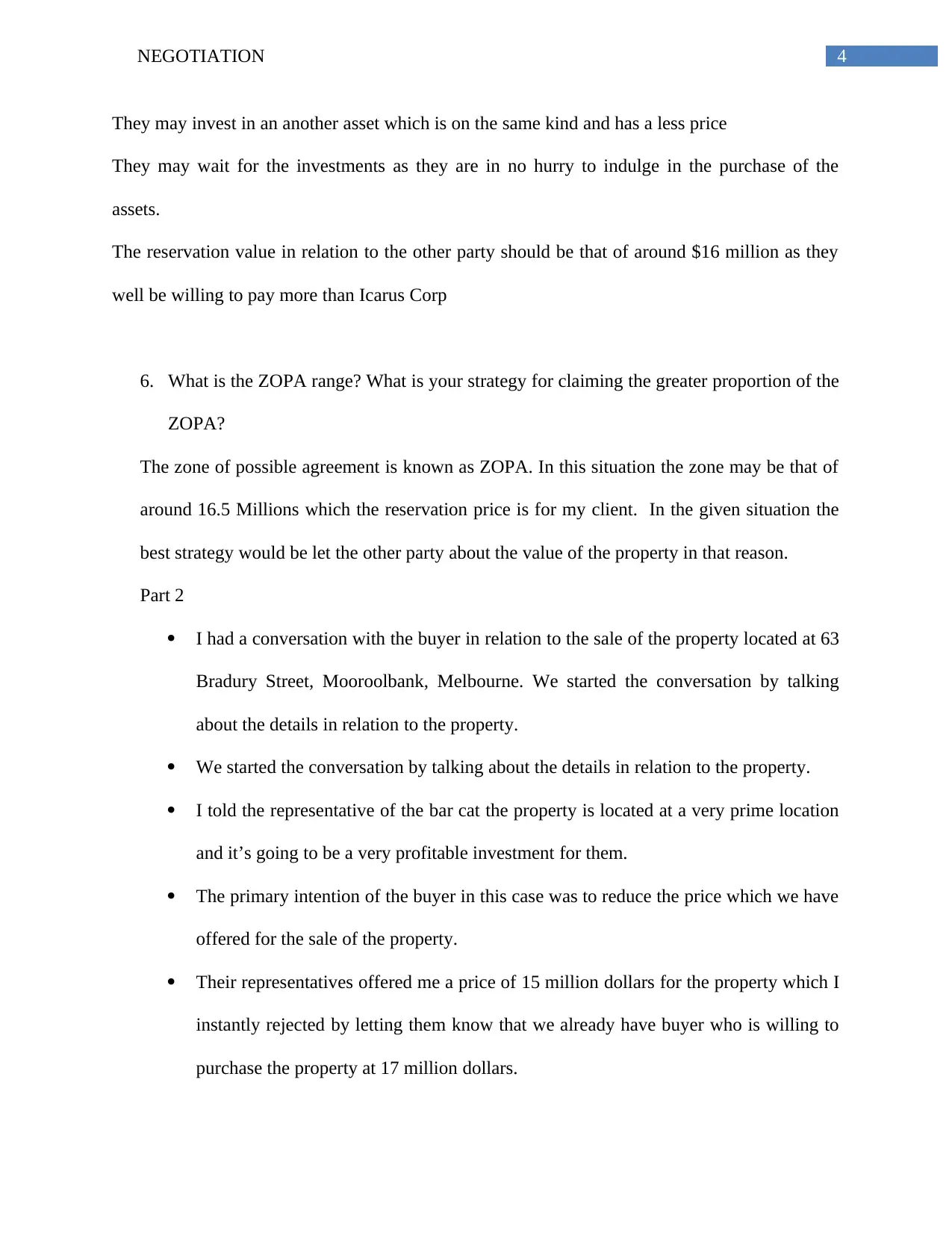
4NEGOTIATION
They may invest in an another asset which is on the same kind and has a less price
They may wait for the investments as they are in no hurry to indulge in the purchase of the
assets.
The reservation value in relation to the other party should be that of around $16 million as they
well be willing to pay more than Icarus Corp
6. What is the ZOPA range? What is your strategy for claiming the greater proportion of the
ZOPA?
The zone of possible agreement is known as ZOPA. In this situation the zone may be that of
around 16.5 Millions which the reservation price is for my client. In the given situation the
best strategy would be let the other party about the value of the property in that reason.
Part 2
I had a conversation with the buyer in relation to the sale of the property located at 63
Bradury Street, Mooroolbank, Melbourne. We started the conversation by talking
about the details in relation to the property.
We started the conversation by talking about the details in relation to the property.
I told the representative of the bar cat the property is located at a very prime location
and it’s going to be a very profitable investment for them.
The primary intention of the buyer in this case was to reduce the price which we have
offered for the sale of the property.
Their representatives offered me a price of 15 million dollars for the property which I
instantly rejected by letting them know that we already have buyer who is willing to
purchase the property at 17 million dollars.
They may invest in an another asset which is on the same kind and has a less price
They may wait for the investments as they are in no hurry to indulge in the purchase of the
assets.
The reservation value in relation to the other party should be that of around $16 million as they
well be willing to pay more than Icarus Corp
6. What is the ZOPA range? What is your strategy for claiming the greater proportion of the
ZOPA?
The zone of possible agreement is known as ZOPA. In this situation the zone may be that of
around 16.5 Millions which the reservation price is for my client. In the given situation the
best strategy would be let the other party about the value of the property in that reason.
Part 2
I had a conversation with the buyer in relation to the sale of the property located at 63
Bradury Street, Mooroolbank, Melbourne. We started the conversation by talking
about the details in relation to the property.
We started the conversation by talking about the details in relation to the property.
I told the representative of the bar cat the property is located at a very prime location
and it’s going to be a very profitable investment for them.
The primary intention of the buyer in this case was to reduce the price which we have
offered for the sale of the property.
Their representatives offered me a price of 15 million dollars for the property which I
instantly rejected by letting them know that we already have buyer who is willing to
purchase the property at 17 million dollars.
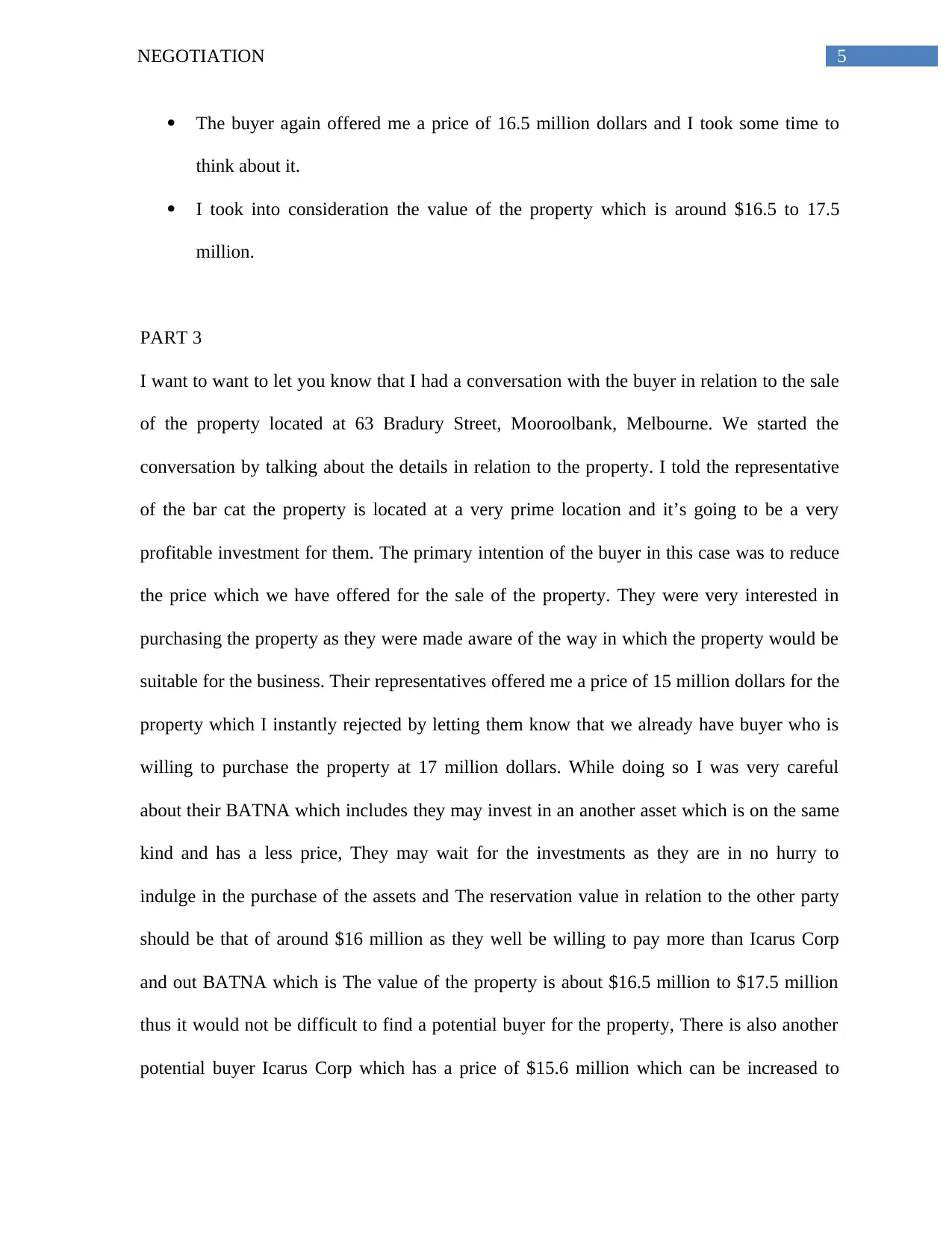
5NEGOTIATION
The buyer again offered me a price of 16.5 million dollars and I took some time to
think about it.
I took into consideration the value of the property which is around $16.5 to 17.5
million.
PART 3
I want to want to let you know that I had a conversation with the buyer in relation to the sale
of the property located at 63 Bradury Street, Mooroolbank, Melbourne. We started the
conversation by talking about the details in relation to the property. I told the representative
of the bar cat the property is located at a very prime location and it’s going to be a very
profitable investment for them. The primary intention of the buyer in this case was to reduce
the price which we have offered for the sale of the property. They were very interested in
purchasing the property as they were made aware of the way in which the property would be
suitable for the business. Their representatives offered me a price of 15 million dollars for the
property which I instantly rejected by letting them know that we already have buyer who is
willing to purchase the property at 17 million dollars. While doing so I was very careful
about their BATNA which includes they may invest in an another asset which is on the same
kind and has a less price, They may wait for the investments as they are in no hurry to
indulge in the purchase of the assets and The reservation value in relation to the other party
should be that of around $16 million as they well be willing to pay more than Icarus Corp
and out BATNA which is The value of the property is about $16.5 million to $17.5 million
thus it would not be difficult to find a potential buyer for the property, There is also another
potential buyer Icarus Corp which has a price of $15.6 million which can be increased to
The buyer again offered me a price of 16.5 million dollars and I took some time to
think about it.
I took into consideration the value of the property which is around $16.5 to 17.5
million.
PART 3
I want to want to let you know that I had a conversation with the buyer in relation to the sale
of the property located at 63 Bradury Street, Mooroolbank, Melbourne. We started the
conversation by talking about the details in relation to the property. I told the representative
of the bar cat the property is located at a very prime location and it’s going to be a very
profitable investment for them. The primary intention of the buyer in this case was to reduce
the price which we have offered for the sale of the property. They were very interested in
purchasing the property as they were made aware of the way in which the property would be
suitable for the business. Their representatives offered me a price of 15 million dollars for the
property which I instantly rejected by letting them know that we already have buyer who is
willing to purchase the property at 17 million dollars. While doing so I was very careful
about their BATNA which includes they may invest in an another asset which is on the same
kind and has a less price, They may wait for the investments as they are in no hurry to
indulge in the purchase of the assets and The reservation value in relation to the other party
should be that of around $16 million as they well be willing to pay more than Icarus Corp
and out BATNA which is The value of the property is about $16.5 million to $17.5 million
thus it would not be difficult to find a potential buyer for the property, There is also another
potential buyer Icarus Corp which has a price of $15.6 million which can be increased to
⊘ This is a preview!⊘
Do you want full access?
Subscribe today to unlock all pages.

Trusted by 1+ million students worldwide
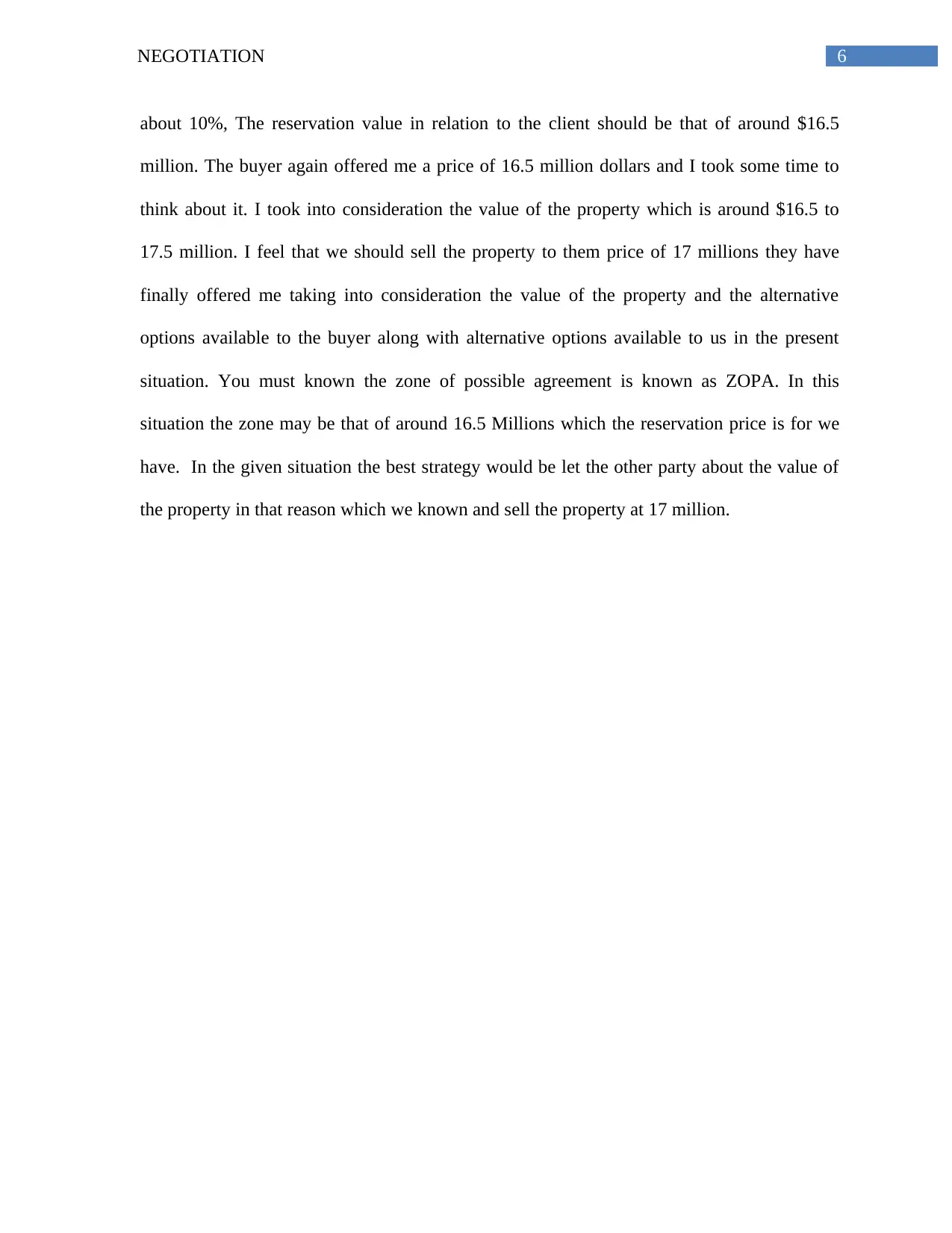
6NEGOTIATION
about 10%, The reservation value in relation to the client should be that of around $16.5
million. The buyer again offered me a price of 16.5 million dollars and I took some time to
think about it. I took into consideration the value of the property which is around $16.5 to
17.5 million. I feel that we should sell the property to them price of 17 millions they have
finally offered me taking into consideration the value of the property and the alternative
options available to the buyer along with alternative options available to us in the present
situation. You must known the zone of possible agreement is known as ZOPA. In this
situation the zone may be that of around 16.5 Millions which the reservation price is for we
have. In the given situation the best strategy would be let the other party about the value of
the property in that reason which we known and sell the property at 17 million.
about 10%, The reservation value in relation to the client should be that of around $16.5
million. The buyer again offered me a price of 16.5 million dollars and I took some time to
think about it. I took into consideration the value of the property which is around $16.5 to
17.5 million. I feel that we should sell the property to them price of 17 millions they have
finally offered me taking into consideration the value of the property and the alternative
options available to the buyer along with alternative options available to us in the present
situation. You must known the zone of possible agreement is known as ZOPA. In this
situation the zone may be that of around 16.5 Millions which the reservation price is for we
have. In the given situation the best strategy would be let the other party about the value of
the property in that reason which we known and sell the property at 17 million.
Paraphrase This Document
Need a fresh take? Get an instant paraphrase of this document with our AI Paraphraser
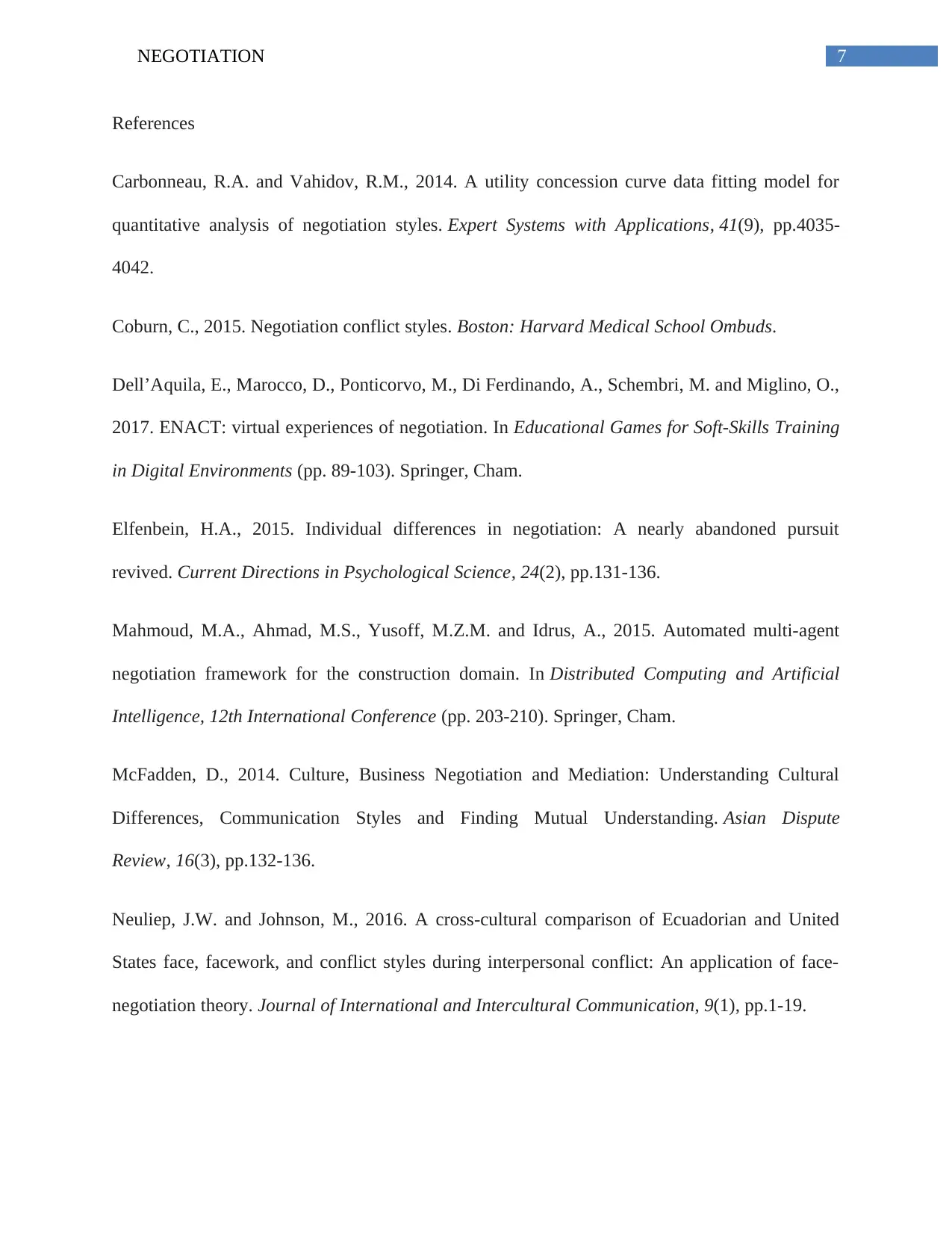
7NEGOTIATION
References
Carbonneau, R.A. and Vahidov, R.M., 2014. A utility concession curve data fitting model for
quantitative analysis of negotiation styles. Expert Systems with Applications, 41(9), pp.4035-
4042.
Coburn, C., 2015. Negotiation conflict styles. Boston: Harvard Medical School Ombuds.
Dell’Aquila, E., Marocco, D., Ponticorvo, M., Di Ferdinando, A., Schembri, M. and Miglino, O.,
2017. ENACT: virtual experiences of negotiation. In Educational Games for Soft-Skills Training
in Digital Environments (pp. 89-103). Springer, Cham.
Elfenbein, H.A., 2015. Individual differences in negotiation: A nearly abandoned pursuit
revived. Current Directions in Psychological Science, 24(2), pp.131-136.
Mahmoud, M.A., Ahmad, M.S., Yusoff, M.Z.M. and Idrus, A., 2015. Automated multi-agent
negotiation framework for the construction domain. In Distributed Computing and Artificial
Intelligence, 12th International Conference (pp. 203-210). Springer, Cham.
McFadden, D., 2014. Culture, Business Negotiation and Mediation: Understanding Cultural
Differences, Communication Styles and Finding Mutual Understanding. Asian Dispute
Review, 16(3), pp.132-136.
Neuliep, J.W. and Johnson, M., 2016. A cross-cultural comparison of Ecuadorian and United
States face, facework, and conflict styles during interpersonal conflict: An application of face-
negotiation theory. Journal of International and Intercultural Communication, 9(1), pp.1-19.
References
Carbonneau, R.A. and Vahidov, R.M., 2014. A utility concession curve data fitting model for
quantitative analysis of negotiation styles. Expert Systems with Applications, 41(9), pp.4035-
4042.
Coburn, C., 2015. Negotiation conflict styles. Boston: Harvard Medical School Ombuds.
Dell’Aquila, E., Marocco, D., Ponticorvo, M., Di Ferdinando, A., Schembri, M. and Miglino, O.,
2017. ENACT: virtual experiences of negotiation. In Educational Games for Soft-Skills Training
in Digital Environments (pp. 89-103). Springer, Cham.
Elfenbein, H.A., 2015. Individual differences in negotiation: A nearly abandoned pursuit
revived. Current Directions in Psychological Science, 24(2), pp.131-136.
Mahmoud, M.A., Ahmad, M.S., Yusoff, M.Z.M. and Idrus, A., 2015. Automated multi-agent
negotiation framework for the construction domain. In Distributed Computing and Artificial
Intelligence, 12th International Conference (pp. 203-210). Springer, Cham.
McFadden, D., 2014. Culture, Business Negotiation and Mediation: Understanding Cultural
Differences, Communication Styles and Finding Mutual Understanding. Asian Dispute
Review, 16(3), pp.132-136.
Neuliep, J.W. and Johnson, M., 2016. A cross-cultural comparison of Ecuadorian and United
States face, facework, and conflict styles during interpersonal conflict: An application of face-
negotiation theory. Journal of International and Intercultural Communication, 9(1), pp.1-19.
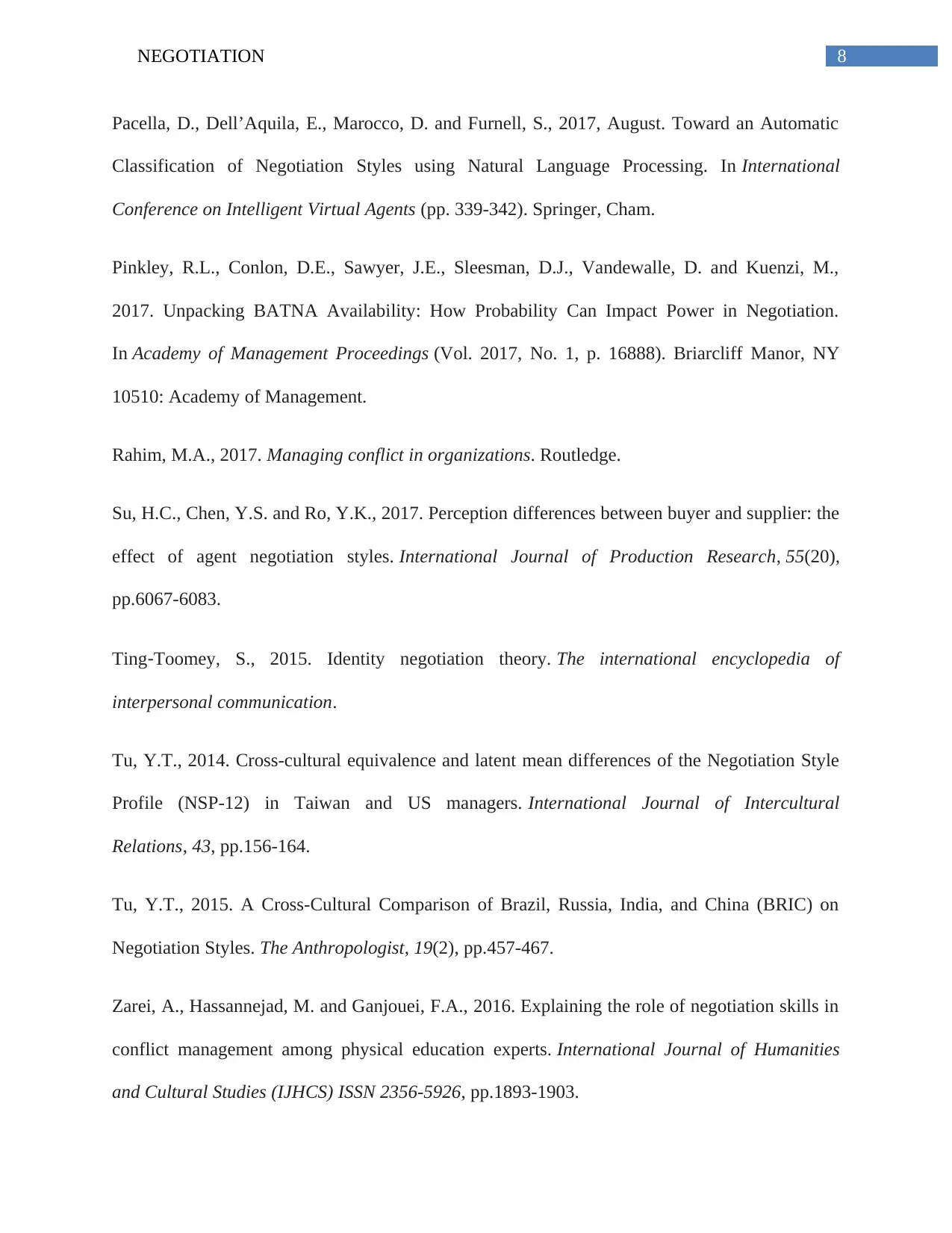
8NEGOTIATION
Pacella, D., Dell’Aquila, E., Marocco, D. and Furnell, S., 2017, August. Toward an Automatic
Classification of Negotiation Styles using Natural Language Processing. In International
Conference on Intelligent Virtual Agents (pp. 339-342). Springer, Cham.
Pinkley, R.L., Conlon, D.E., Sawyer, J.E., Sleesman, D.J., Vandewalle, D. and Kuenzi, M.,
2017. Unpacking BATNA Availability: How Probability Can Impact Power in Negotiation.
In Academy of Management Proceedings (Vol. 2017, No. 1, p. 16888). Briarcliff Manor, NY
10510: Academy of Management.
Rahim, M.A., 2017. Managing conflict in organizations. Routledge.
Su, H.C., Chen, Y.S. and Ro, Y.K., 2017. Perception differences between buyer and supplier: the
effect of agent negotiation styles. International Journal of Production Research, 55(20),
pp.6067-6083.
Ting‐Toomey, S., 2015. Identity negotiation theory. The international encyclopedia of
interpersonal communication.
Tu, Y.T., 2014. Cross-cultural equivalence and latent mean differences of the Negotiation Style
Profile (NSP-12) in Taiwan and US managers. International Journal of Intercultural
Relations, 43, pp.156-164.
Tu, Y.T., 2015. A Cross-Cultural Comparison of Brazil, Russia, India, and China (BRIC) on
Negotiation Styles. The Anthropologist, 19(2), pp.457-467.
Zarei, A., Hassannejad, M. and Ganjouei, F.A., 2016. Explaining the role of negotiation skills in
conflict management among physical education experts. International Journal of Humanities
and Cultural Studies (IJHCS) ISSN 2356-5926, pp.1893-1903.
Pacella, D., Dell’Aquila, E., Marocco, D. and Furnell, S., 2017, August. Toward an Automatic
Classification of Negotiation Styles using Natural Language Processing. In International
Conference on Intelligent Virtual Agents (pp. 339-342). Springer, Cham.
Pinkley, R.L., Conlon, D.E., Sawyer, J.E., Sleesman, D.J., Vandewalle, D. and Kuenzi, M.,
2017. Unpacking BATNA Availability: How Probability Can Impact Power in Negotiation.
In Academy of Management Proceedings (Vol. 2017, No. 1, p. 16888). Briarcliff Manor, NY
10510: Academy of Management.
Rahim, M.A., 2017. Managing conflict in organizations. Routledge.
Su, H.C., Chen, Y.S. and Ro, Y.K., 2017. Perception differences between buyer and supplier: the
effect of agent negotiation styles. International Journal of Production Research, 55(20),
pp.6067-6083.
Ting‐Toomey, S., 2015. Identity negotiation theory. The international encyclopedia of
interpersonal communication.
Tu, Y.T., 2014. Cross-cultural equivalence and latent mean differences of the Negotiation Style
Profile (NSP-12) in Taiwan and US managers. International Journal of Intercultural
Relations, 43, pp.156-164.
Tu, Y.T., 2015. A Cross-Cultural Comparison of Brazil, Russia, India, and China (BRIC) on
Negotiation Styles. The Anthropologist, 19(2), pp.457-467.
Zarei, A., Hassannejad, M. and Ganjouei, F.A., 2016. Explaining the role of negotiation skills in
conflict management among physical education experts. International Journal of Humanities
and Cultural Studies (IJHCS) ISSN 2356-5926, pp.1893-1903.
⊘ This is a preview!⊘
Do you want full access?
Subscribe today to unlock all pages.

Trusted by 1+ million students worldwide

9NEGOTIATION
1 out of 10
Related Documents
Your All-in-One AI-Powered Toolkit for Academic Success.
+13062052269
info@desklib.com
Available 24*7 on WhatsApp / Email
![[object Object]](/_next/static/media/star-bottom.7253800d.svg)
Unlock your academic potential
Copyright © 2020–2025 A2Z Services. All Rights Reserved. Developed and managed by ZUCOL.





